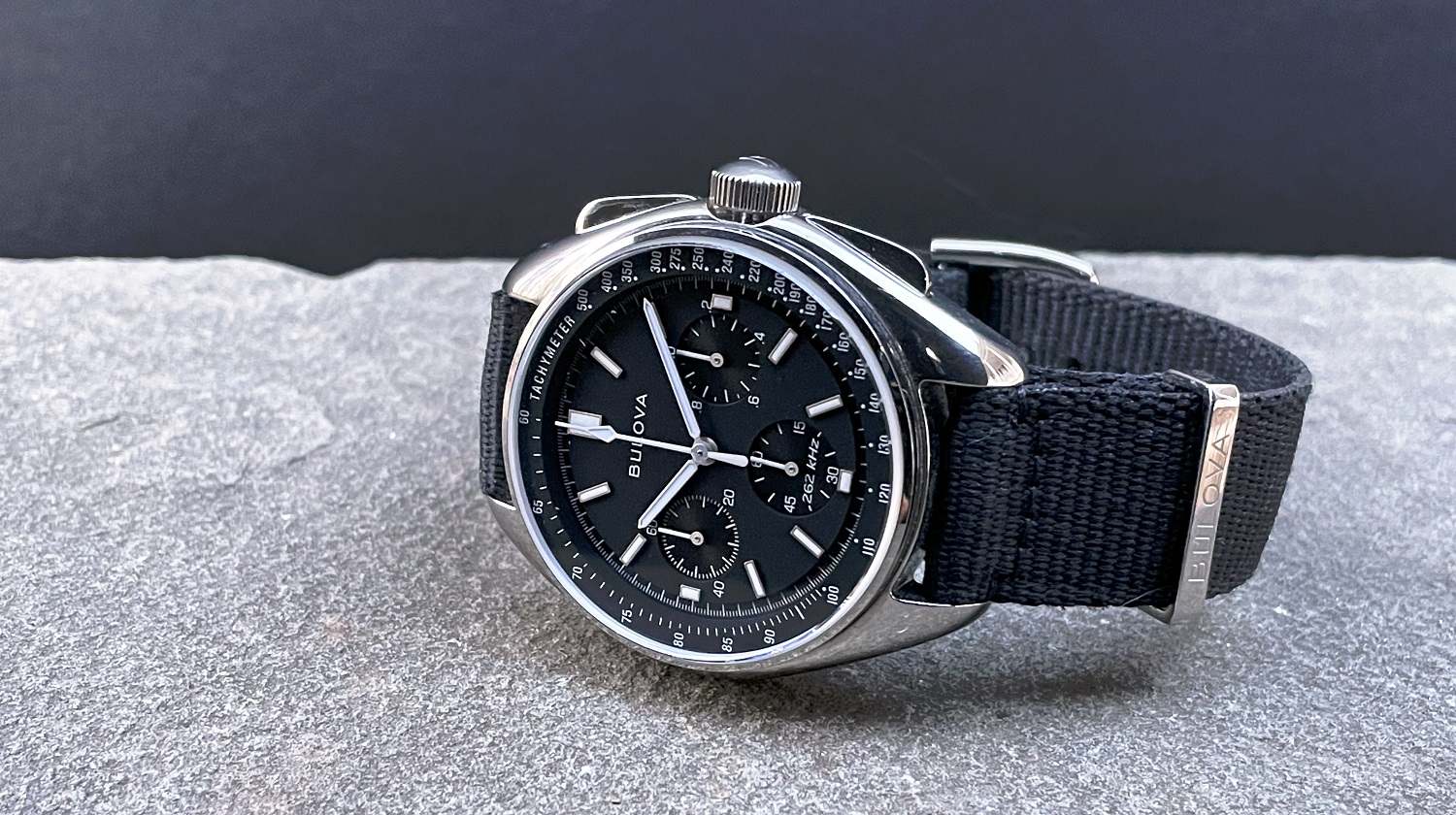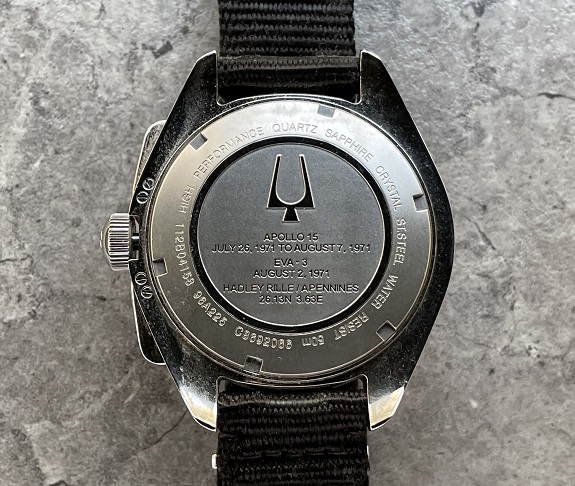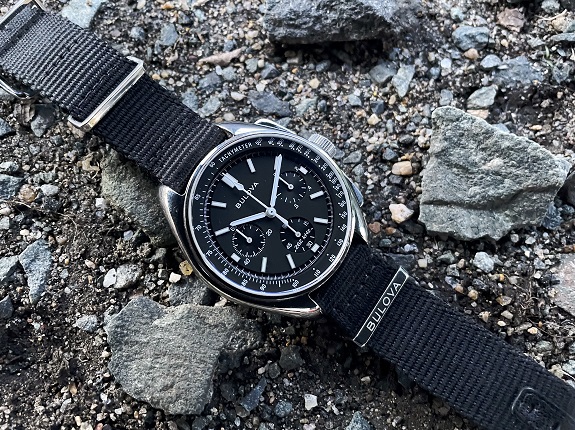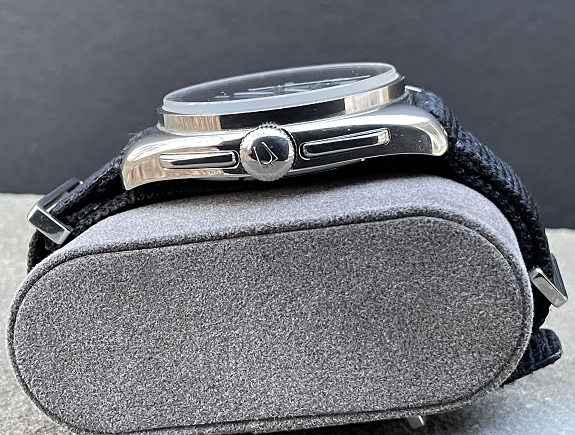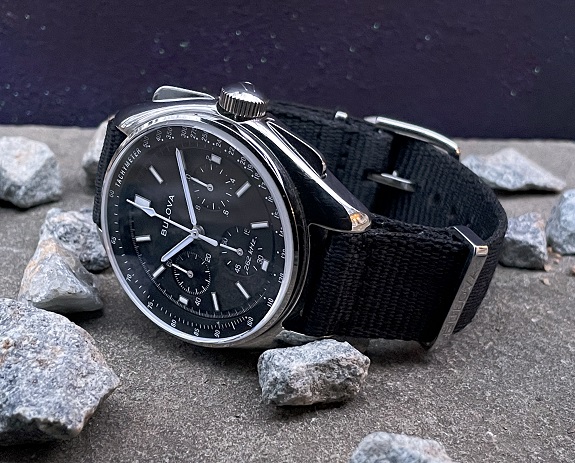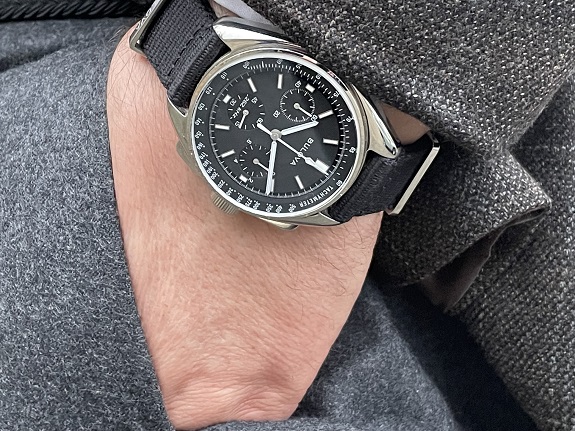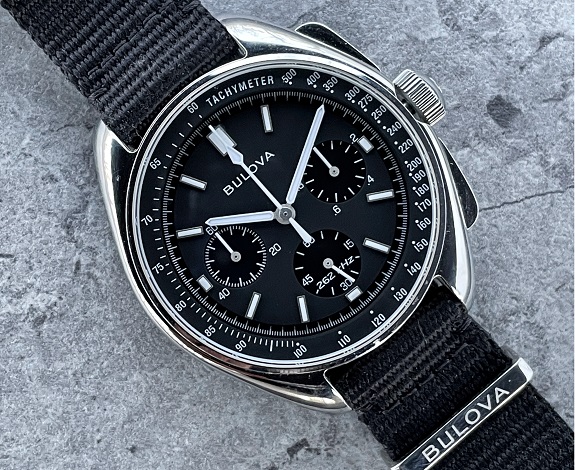Bulova Archive Series Lunar Pilot 96A225 – $378.99
About the Author: John B. is a retired US Army tank officer, husband, and father living in Northern Virginia. When he’s not spending time with his family, he enjoys traditional archery, mountain biking, canoeing and the occasional pour of nice bourbon.
This year marks the 50th anniversary of the end of the Apollo program, and it’s already been a big year for “moon” watches. But if you can’t get your hands on the new MoonSWATCH or afford a real McCoy Omega Speedmaster, are you just straight outta luck? Fortunately, as everyone’s favorite little green Jedi Master once said, “No, there is another.” Enter the Bulova Lunar Pilot.
Background
NASA famously issued the Apollo astronauts Omega Speedmaster chronographs for their horological needs, but Bulova, which produced the chronometric instrumentation for the Apollo spacecraft, wanted in on the watch action. Bulova adapted a different Swiss chronograph design and gave away the prototypes to astronauts for “testing”. On Day 2 of Apollo 15’s stay on the Moon, mission commander Dave Scott strapped on his Bulova when his Omega lost its crystal. One small step for Dave, one giant leap for Bulova watch sales. Bulova never dethroned the Speedy as NASA’s official watch, but Scott kept his prototype and sold it at auction in 2015 for a cool $1.6 million. At that time, that was the highest price ever paid for a watch (but has since been well surpassed). The excitement inspired Bulova to cash in themselves with a line of chronographs celebrating the original Apollo 15 watch.
Not all Moonwatches are Omega (or Swatch interpretations)
Form
Like the original, the reproduction Bulova Lunar Pilot features an elegantly shaped body with a meaty crown between elongated pushers, three subdials on the face, long fencepost hands, and a tachymeter. Unlike the original, Bulova modernized the design with a sapphire crystal, a date window on some versions, and a high-beat quartz movement. The stainless steel case is a chunky, but manageable, 45mm x 52mm x 13.5 mm. The 20mm lug width makes swapping the band a cinch. The case back features Bulova’s signature “tuning fork” logo, the Apollo 15 mission dates, and the time and lunar geography of Scott’s first moonwalk with the Bulova prototype. MSRP runs $550-$600 depending on the version, but the price fluctuates, sometimes as low as $350.
The dial comes in any color you like, as long as it’s black. However, there are some case and band options:
- Matte silver case with date complication on a leather band and optional black NATO
- Matte case and date on a stainless bracelet
- Blacked-out case sans date complication on a black leather NATO
- Polished case sans date on a black nylon NATO
I opted for the last version because it is, to my eye, the closest spec to the original worn by Dave Scott, and it didn’t hurt that it was the least expensive one when I bought it.
Before we go any further, there are a couple of elephants in the room that need acknowledging…
Three sub dials. Black and white color scheme. Tachymeter. Look familiar?
“The moon… beautiful.”
It’s a Speedmaster rip-off! Well, no not really. Okay, maybe a little bit. Here’s the thing – the OG watch had to meet the same NASA specs as,the Speedmaster. So it is a rip-off, but not really Bulova’s fault. Er, something.
My God, that thing is… quartz! Oh, the humanity! HIGH-beat quartz, thank you very much. At 262 kHz frequency, this movement vibrates eight times faster than a standard quartz and is accurate to a few seconds a year. It’s a fitting successor to Bulova’s pioneering Accutron electronic movement introduced in 1960.
The dial is an easy to read white-on-black and blessedly devoid of extraneous graphics; only a “BULOVA” in small block letters intrudes upon the instrumentation. When you look at the watch, your eye is immediately drawn to the movement of the sub-seconds dial at 6 o’clock, beating along at two ticks per second. The long pointed second hand on the main dial is for the chronograph and is, for the moment at least, perfectly still. The remaining subdials at 9 and 3 are respectively the chrono’s minute and millisecond readings, also at rest with their hands pointing straight up. The minute and hour hands are long fence pickets that reach all the way to their respective indices, an underrated feature for easy time telling. Simple raised hour markers intermingle with indices marking the minutes and 1/5s around the main dial, while the three subdials are debossed, making the watch face marvelously three dimensional. A tachymeter on a raised inner bezel circumnavigates the whole affair under a thick slab of flat sapphire crystal.
Chunky yet surprisingly wearable 45mm case.
Lugs are 20mm, just like a 38mm Timex weekender.
Function
The watch functions magnificently. I love futzing with my auto watches, but there is something to be said for the grab and go simplicity of high performance quartz. Set it once and don’t check it until daylight saving time changes. When you do need to set the time, the crown is a joy to operate. It snicks and snacks with the authority you expect from a top shelf watch. Water resistance is only 50m, but fortunately there’s not a lot of agua on the Moon. The lume is adequate, but not spectacular. The hour indices, fencepost hands, and big second hand light up with authority after a fresh charge, but unfortunately the sub-seconds dial does not. If you want to measure elapsed seconds on the dark side of the Moon, you’ll have to start the chrono. And what a chrono!
Sapphire crystal. Big crown and chrono pushers.
The main second hand stands at attention like an upright lance, motionless, waiting for you – nay, begging you – to hit the top pusher. When you oblige it, the fun begins! The long lance breaks free of its vigil at the top position and begins a graceful sweep. Concurrently, the millisecond sub-dial at three o’clock fires into a frenzy, whirring around the dial for the first thirty seconds in perfect synchronization with the beats of the big hand. Meanwhile, the minute sub-dial also steps off at its stately pace, imperceptible at first, but steadily advancing as the sweeping second hand completes its orbits. Depress the top pusher again and the second and minute hands freeze, while the millisecond hand spins to the correct reading. Once again, the only motion on the watch face is the tick-tick, tick-tick of the sub-seconds dial. Reading the elapsed time on the second and millisecond hands are simple enough. However, reading the minute dial is a pure vision test, no doubt intended to weed out the optically unfit from astronaut service. Punch the bottom pusher and the chronograph resets as the hands simultaneously swing clockwise back to 12 o’clock. Needless to say, for pure practicality, the stopwatch on your smartphone wins every time. But there is certainly something sensuously special about measuring time the old school way – the tactile “click” of the pusher, the visual feast of spinning dials – that a smartphone just can’t capture.
High-beat At 262 kHz movement accurate to a few seconds a year.
“Every year is getting shorter“… Not with this watch.
Wear
For me, the Lunar Pilot strikes the right balance of being unique, but not showy. It has the presence of a larger watch without the gaudiness of a “dinnerplate”. It’s at home with many more outfits than you’d think. The main limitation with dressier attire is that it’s a biggun’ that doesn’t fit under a dress shirt sleeve too well. But a lot of us live with that with many of our watches. Sportcoat, button down, & jeans? This absolutely looks at home with that sort of outfit. As it does with a t-shirt and beat up chinos and boots on the weekend. It can even be worth with crisper shirts, tailored blazers, and dress trousers.
Is it a dress watch? No.
Can you wear it dressed up? Sure!
Final Thoughts
Who should get a Lunar Pilot? Do you love NASA history and want to literally wear it on your sleeve – check! Do you need a large watch for a large wrist and don’t care for divers or monstrous Invictas – check! Do you want a versatile and classy chrono that’s a step up from Timex and Casio – check! Do you just think it looks cool (and can’t afford a Speedy) – check and check! If you fall into any of the above categories or dig this watch for any other reason, I think you’ll find the Bulova Lunar Pilot a solid buy.
That’s Amore
